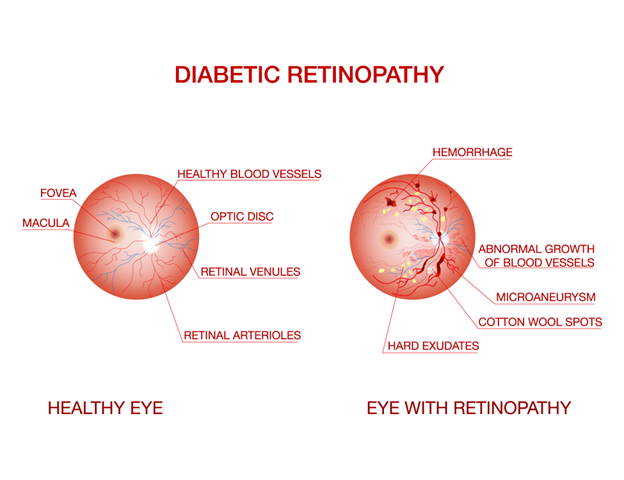Diabetic retinopathy is a significant health issue worldwide, including in India, due to the growing number of diabetes cases. It affects the eyes and can lead to blindness if not managed properly. The disease is caused by damage to the blood vessels in the retina, the light-sensitive tissue at the back of the eye. Notably, early detection plays a vital role in its management. People with diabetes need to be aware of prevention strategies to tackle this condition effectively.
A Deep Dive into Diabetic Retinopathy
High blood sugar levels can damage the small blood vessels in the retina. This damage occurs when blood sugar is not controlled effectively. Over time, the tiny vessels can leak or swell, distorting vision. As the condition worsens, new, abnormal blood vessels might grow, leading to severe vision problems. The importance of spreading awareness about diabetic retinopathy is crucial. Educating people on this condition can help in early detection and management, decreasing the chances of severe outcomes.
Recognizing the Signs and Symptoms
Spotting the signs of diabetic retinopathy is essential: – Blurred vision – Seeing floaters or dark spots – Sudden changes in vision
Identifying these symptoms early can significantly affect the treatment process. Quick diagnosis leads to timely medical intervention, preventing further damage. Often, people ignore early signs, delaying crucial eye exams. Thus, regular check-ups can keep vision complications at bay. Remember, an attentive approach in recognizing symptoms ensures better outcomes.
Decoding the Causes of Diabetic Retinopathy
The root cause of diabetic retinopathy is unmanaged diabetes. High blood sugar levels harm the retina’s blood vessels. Other factors contribute as well: – Hypertension: High blood pressure strains the eyes. – High Cholesterol: Elevated fat levels interfere with blood flow to the retina.
Maintaining healthy blood sugar, cholesterol, and pressure levels reduce the risk of diabetic retinopathy. A comprehensive approach to health management prevents severe retinal damage. Understanding these contributing factors aids in formulating a solid prevention plan.
Effective Prevention Techniques
Preventing diabetic retinopathy involves maintaining stable blood glucose levels. Here’s how: 1. Nutrition: Consuming a balanced diet with vegetables and whole grains helps keep blood sugar in check. 2. Physical activity: Regular exercise, like walking or cycling, improves overall health. 3. Routine Eye Exams: Schedule eye checks at least once a year to catch any early changes.
Staying committed to these steps significantly impacts eye health. Monitoring and managing health effectively can prevent this debilitating eye condition. Adopting a preventive lifestyle is key to reducing complications.
Linking Diabetes Management with Retinopathy Prevention
Managing diabetes well can reduce the risk of diabetic retinopathy remarkably. Proven strategies include: – Healthy Eating: Whole foods, low sugar. – Regular Exercise: Keeps insulin levels stable. – Monitoring Blood Sugar: Using a home glucose test regularly.
These methods are essential to control blood sugar levels. Education on these techniques empowers individuals to safeguard their eye health. Sharing knowledge on diabetes care helps lessen the impact of diabetic retinopathy.
Inspiring Narratives of Triumph
Real stories of managing diabetic retinopathy serve as motivation. Individuals who took charge of their health inspire others. One story might feature a person who adopted diet changes, leading to significant health improvement. Another might highlight someone benefiting from regular eye exams and exercise. These personal tales provide lessons in resilience and determination. Facing challenges with a positive mindset can overcome hurdles effectively. These narratives show that proactive steps can control diabetic retinopathy.
Myth-busting Alert: Debunking False Beliefs
There are several myths about diabetic retinopathy that can mislead people: – Myth: Only severe diabetics get retinopathy. – Truth: Any person with diabetes is at risk.
- Myth: It manifests noticeable symptoms early on.
- Truth: Often, early stages display no symptoms.
Clear information and education can dispel these myths. Raising awareness about the realities of diabetic retinopathy ensures that people seek the right prevention and treatment. Understanding facts helps in making informed health decisions.
Exploring Advancements in Treatment
Recent breakthroughs in diabetic retinopathy treatment are promising, especially in India. Innovative procedures, such as advanced laser treatments, have made significant strides. Other approaches, like injections and medications, aim to limit abnormal blood vessel growth. These advancements improve the quality of life and prognosis for affected individuals, allowing for more effective management of the condition. Staying updated on these treatments helps individuals make informed choices about their eye health. The evolving medical landscape offers enhanced hope.
Lifestyle Choices: The Cornerstone of Prevention
Engaging in regular exercise controls diabetes effectively, helping prevent diabetic retinopathy. Simple activities, like walking, positively impact eye health by keeping blood sugar stable. Adjustments in diet are also crucial. Reducing sugar and processed foods helps lower the risk of developing retinopathy. Prioritizing health-enhancing habits supports overall well-being. These lifestyle choices form the foundation for a healthy future, keeping vision intact and diabetes complications afar.
Unveiling Socioeconomic Factors in India
In India, economic challenges contribute to higher rates of diabetic retinopathy. Many people face barriers to accessing timely eye care due to cost. Addressing these problems requires collaboration. Community programs and government support can offer affordable screenings and treatments. By acknowledging and tackling these socioeconomic factors, the impact of diabetic retinopathy can be reduced. Emphasizing equal healthcare access ensures everyone receives necessary medical attention and preventative care.
A Call to Action: Protect Your Vision
Act now to safeguard your eyesight! If diabetes runs in your family, start taking preventive steps. Get regular eye check-ups and keep a close watch on your blood sugar levels. By adopting a proactive approach, especially routine screenings, you’ll be more vigilant in protecting your vision. Embrace healthy habits wholeheartedly. Encourage others to follow suit by sharing helpful information. Together, we can diminish the impact of diabetic retinopathy.
Conclusion: Towards a Healthier Vision
Remember, diabetic retinopathy is manageable with awareness and action. Control your diabetes to protect your eyes. Simple lifestyle changes can make a massive difference. Prioritize eye health to avoid potential blindness. Let’s take those steps together for a future with clearer vision. Spread the word and inspire others to join you. Your eyes matter — ensure they’re a priority today!

